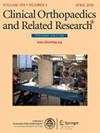Isolated Limb Perfusion Can Avert Amputation Indication in Initially Nonsalvageable Sarcomas of the Extremities.
IF 4.4
2区 医学
Q1 ORTHOPEDICS
引用次数: 0
Abstract
BACKGROUND Because of their aggressive nature and limited treatment options, soft tissue sarcomas present a significant challenge for patients. Isolated limb perfusion with tumor necrosis factor α and melphalan (TM-ILP) has emerged as a promising modality against soft tissue sarcomas aimed at downstaging tumors with significant local invasion, offering a localized approach to deliver high doses of chemotherapy directly to the affected limb while minimizing systemic toxicity. However, its feasibility in centers with limited experience and its true impact on limb salvage remain unclear. Our study aims to address these knowledge gaps by evaluating outcomes in a diverse patient population and assessing factors that influence treatment success and limb preservation. QUESTIONS/PURPOSES (1) What was the cumulative incidence of amputations at 12 months after TM-ILP in patients with tumors that were initially considered nonsalvageable? (2) What proportion of patients treated with this approach developed early severe complications, defined as death of the patient, compartment syndrome of the treated extremity, or a treatment reaction leading to limb amputation within 30 days from the ILP procedure? (3) What was the all-cause survivorship and survivorship free from local recurrence in patients treated with TM-ILP? METHODS A retrospective observational study was conducted on patients who underwent TM-ILP for a soft tissue sarcoma that was deemed not amenable for limb salvage between July 2016 and June 2023. During this time, among a total of 528 patients treated for soft tissue sarcoma, 36 patients not considered candidates for a limb salvage procedure by a multidisciplinary tumor board were recommended for TM-ILP. The determination of limb nonsalvageability was based on the feasibility of achieving negative surgical margins and adequate soft tissue coverage after resection. Two patients declined TM-ILP, and a total of 34 patients were included in the study. After the TM-ILP treatment, an MRI was performed, and the feasibility of a limb salvage procedure was reassessed by the same multidisciplinary team against the same initial criteria. There were 12 females and 22 males, and the mean ± SD age was 55 ± 17 years. The most common sarcomas were of the lower extremity (62% [21 of 34]). The most frequent diagnoses were undifferentiated pleomorphic sarcoma (18% [6]) and myxoid liposarcoma (18% [6]). Seventy-six percent (26 of 34) of patients completed ILP followed by surgery, which took place between 2 and 3 months from TM-ILP. For the remaining eight patients, in four patients ILP could not be completed (two attributed to leaks, one attributed to arterial blockage, and one attributed to insufficient venous return), and the additional four patients elected not to proceed with surgery because of systemic disease progression. Seventy-nine percent (27 of 34) of patients were alive and had a documented follow-up of at least 1 year after treatment. To estimate the cumulative incidence of amputation-free survival, we used the survival package in R, version 4.3.2, considering death of the patient as a competing event. For Question 2, the proportion of patients experiencing severe complications was calculated by dividing the number of patients with at least one severe complication by the total number of patients in the cohort, expressed as a percentage. All-cause survivorship and survivorship free from local recurrence analysis for Question 3 was performed using a Kaplan-Meier estimator analysis with SPSS Statistics 29.0.2.0 (IBM). RESULTS The cumulative incidence of amputations at 12 months after TM-ILP treatment was 13% (95% confidence interval [CI] 75% to 100%) in patients initially deemed to have unresectable lesions. Zero percent (0 of 34) had major complications, death attributed to TM-ILP treatment (0 of 34), compartment syndrome (0 of 34), and amputation attributed to reaction to TM-ILP (0 of 34). All-cause survivorship was 77% (95% CI 63% to 90%) at 12 months and 58% (95% CI 42% to 75%) at 24 months. Local recurrence-free survival at 12 months was 93% (95% CI 83% to 100%) and 84% (95% CI 71% to 97%) at 24 months. CONCLUSION In this small, retrospective series, TM-ILP allowed limb-sparing surgery in patients with locally advanced or recurrent extremity sarcomas considered borderline resectable. While early results are encouraging, further studies with larger cohorts and longer follow-up times are needed to clarify the role of TM-ILP in multidisciplinary sarcoma care. LEVEL OF EVIDENCE Level IV, therapeutic study.孤立肢体灌注可以避免最初无法挽救的四肢肉瘤的截肢指征。
由于其侵袭性和有限的治疗选择,软组织肉瘤对患者提出了重大挑战。孤立肢体灌注肿瘤坏死因子α和melphalan (TM-ILP)已成为一种有希望的治疗软组织肉瘤的方式,旨在降低局部侵袭的肿瘤分期,提供一种局部方法,直接向受影响的肢体提供高剂量的化疗,同时将全身毒性降到最低。然而,其在经验有限的中心的可行性及其对肢体挽救的真正影响仍不清楚。我们的研究旨在通过评估不同患者群体的结果和评估影响治疗成功和肢体保存的因素来解决这些知识空白。问题/目的(1)对于最初被认为不可救药的肿瘤患者,在TM-ILP后12个月的累计截肢发生率是多少?(2)采用这种方法治疗的患者中有多少比例出现了早期严重并发症,定义为患者死亡、被治疗肢体间室综合征,或在ILP手术后30天内出现导致截肢的治疗反应?(3) TM-ILP治疗患者的全因生存率和无局部复发生存率是多少?方法对2016年7月至2023年6月期间因软组织肉瘤接受TM-ILP治疗的患者进行回顾性观察研究,该患者被认为不适合肢体保留。在此期间,总共528例接受软组织肉瘤治疗的患者中,36例被多学科肿瘤委员会认为不适合肢体保留手术的患者被推荐进行TM-ILP。肢体不可修复性的确定是基于切除后获得负手术切缘和足够的软组织覆盖的可行性。2例患者拒绝接受TM-ILP治疗,共纳入34例患者。在TM-ILP治疗后,进行MRI检查,并由同一多学科团队根据相同的初始标准重新评估肢体保留手术的可行性。女性12例,男性22例,平均±SD年龄55±17岁。最常见的肉瘤发生在下肢(62%[21 / 34])。最常见的诊断是未分化多形性肉瘤(18%[6])和黏液样脂肪肉瘤(18%[6])。76%(34名中的26名)的患者完成了ILP,随后进行了手术,手术在TM-ILP后的2至3个月内进行。在其余8例患者中,有4例患者无法完成ILP(2例归因于泄漏,1例归因于动脉阻塞,1例归因于静脉回流不足),另外4例患者由于全体性疾病进展而选择不进行手术。79%(34名患者中的27名)的患者存活,并在治疗后进行了至少1年的记录随访。为了估计无截肢生存的累积发生率,我们使用了R 4.3.2版中的生存包,将患者死亡视为一个竞争事件。对于问题2,出现严重并发症的患者比例通过将至少出现一种严重并发症的患者人数除以队列中患者总数来计算,以百分比表示。问题3的全因生存率和无局部复发生存率分析采用Kaplan-Meier估计分析,使用SPSS Statistics 29.0.2.0 (IBM)进行。结果在最初被认为有不可切除病变的患者中,TM-ILP治疗后12个月的累计截肢发生率为13%(95%可信区间[CI] 75%至100%)。0%(34例中0例)有主要并发症,死亡归因于TM-ILP治疗(34例中0例),室室综合征(34例中0例),截肢归因于TM-ILP反应(34例中0例)。12个月时全因生存率为77% (95% CI 63% - 90%), 24个月时为58% (95% CI 42% - 75%)。12个月时局部无复发生存率为93% (95% CI 83% - 100%), 24个月时为84% (95% CI 71% - 97%)。结论:在这个小型的回顾性研究中,TM-ILP允许局部晚期或复发的边缘可切除的肢体肉瘤患者进行保肢手术。虽然早期结果令人鼓舞,但需要更大的队列和更长的随访时间进行进一步的研究,以阐明TM-ILP在多学科肉瘤治疗中的作用。证据等级:IV级,治疗性研究。
本文章由计算机程序翻译,如有差异,请以英文原文为准。
求助全文
约1分钟内获得全文
求助全文
来源期刊
CiteScore
7.00
自引率
11.90%
发文量
722
审稿时长
2.5 months
期刊介绍:
Clinical Orthopaedics and Related Research® is a leading peer-reviewed journal devoted to the dissemination of new and important orthopaedic knowledge.
CORR® brings readers the latest clinical and basic research, along with columns, commentaries, and interviews with authors.

 求助内容:
求助内容: 应助结果提醒方式:
应助结果提醒方式:


